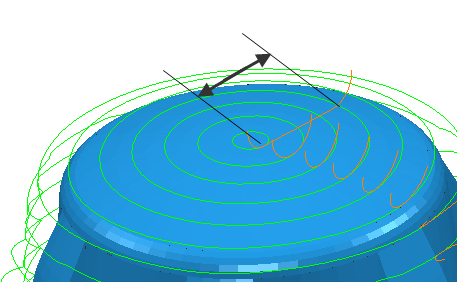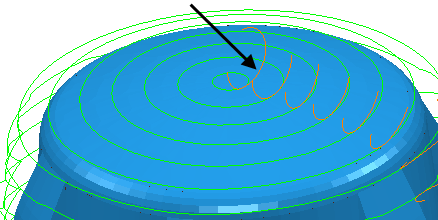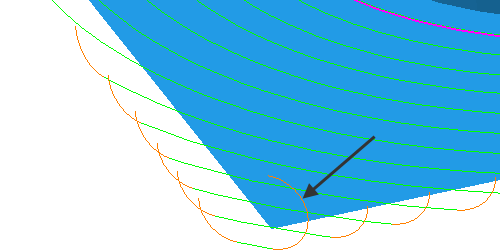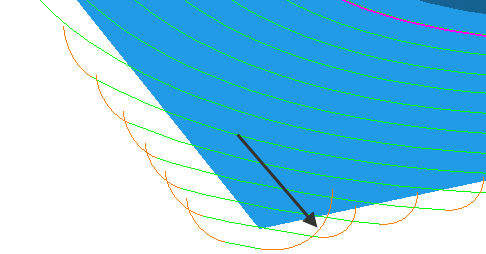Use the options on the First and last leads page to control the:
- Separate first lead in move that is different from the subsequent lead in moves.
These options are not available for Vortex toolpaths.
- Separate last lead out move that is different from the previous lead out moves.
Separate first lead in
Separate first lead in — Select this option to specify a different first lead in move. This offer similar functionality as the Lead ins area, but applies it only to the first lead in move.
This example uses a Lead in and Lead out of Surface normal arc.
-
Use a separate first lead in deselected:

 A
First lead in
of
Surface normal arc with a
Distance of
0, an
Angle
of
90 and a
Radius of
5.
A
First lead in
of
Surface normal arc with a
Distance of
0, an
Angle
of
90 and a
Radius of
5.
-
Use a separate first lead in selected:

 A
First lead in
of
Ramp (where the ramp follows the toolpath).
A
First lead in
of
Ramp (where the ramp follows the toolpath).
Choice — Select the type of move to use at the start of the toolpath.
Linear move — Enter the distance to extend the Separate first lead in move before the cutting move starts. The distance is the length of the linear tangential move between the arc and the cutting portion of the toolpath. This option is available only for a Choice of: Surface normal arc, Vertical arc, Horizontal arc, Horizontal arc left, and Horizontal arc right.
-
Distance of
0.

 A
First lead in
of
Surface normal arc with a
Distance of
0, an
Angle
of
90 and a
Radius of
5.
A
First lead in
of
Surface normal arc with a
Distance of
0, an
Angle
of
90 and a
Radius of
5.
-
Distance of
10.

Angle — Enter the angle of the Separate first lead in move relative to the first toolpath segment. For arcs, this is the angle spanned by the arc. For lines, it is the orientation relative to the cutting move. This option is available only for a Choice of: Surface normal arc, Vertical arc, Horizontal arc, Horizontal arc left, Horizontal arc right, and Straight.
-
Angle of
90
 .
.

 A
First lead in
of
Surface normal arc with a
Distance of
0, an
Angle
of
90 and a
Radius of
5.
A
First lead in
of
Surface normal arc with a
Distance of
0, an
Angle
of
90 and a
Radius of
5.
Angle of 180
 .
.

- For a
First lead in of
Straight and
Angle of
0
 .
.

-
Angle of
90
 .
.

Radius — Enter the radius of the Separate first lead in arc move. This option is available only for a Choice of: Surface normal arc, Vertical arc, Horizontal arc, Horizontal arc left, and Horizontal arc right.
-
Radius of
5.

 A
First lead in
of
Surface normal arc with a
Distance of
0, an
Angle
of
90 and a
Radius of
5.
A
First lead in
of
Surface normal arc with a
Distance of
0, an
Angle
of
90 and a
Radius of
5.
-
Radius of
10.

Length — Enter the length to extend the Separate first lead in move before the cutting move starts. This option is available only for a Choice of: Extended move, Boxed, and Straight.
 Ramp Options
— Click to display the
First Lead in Ramp Options dialog where you can specify how the tool ramps into the stock. This is the same as the
Lead in Ramp Options dialog, except there is no
2nd Choice tab. This is available only when you select a
Choice of
Ramp.
Ramp Options
— Click to display the
First Lead in Ramp Options dialog where you can specify how the tool ramps into the stock. This is the same as the
Lead in Ramp Options dialog, except there is no
2nd Choice tab. This is available only when you select a
Choice of
Ramp.
Separate last lead out
Separate last lead out — Select this option to specify a different last lead out move. This offer similar functionality as the Lead outs area, but applies it only to the last lead out move.
This example uses a Lead in and Lead out of Surface normal arc.
-
Use a separate last lead out deselected:

 A
Last lead out
of
Surface normal arc with a
Distance of
0, an
Angle
of
90 and a
Radius of
5.
A
Last lead out
of
Surface normal arc with a
Distance of
0, an
Angle
of
90 and a
Radius of
5.
-
Use a separate first lead in selected:

 A
Last lead out
of
Straight with a
Distance of
20 and an
Angle of
0.
A
Last lead out
of
Straight with a
Distance of
20 and an
Angle of
0.
Choice — Select the type of move to use at the end of the toolpath.
Linear move — Enter the distance to extend the Last lead out move after the end of the last cutting move. The distance is the length of the linear tangential move between the arc and the cutting portion of the toolpath. This option is available only for a Choice of: Surface normal arc, Vertical arc, Horizontal arc, Horizontal arc left, and Horizontal arc right.
-
Distance of
0.

 A
Last lead out
of
Surface normal arc with a
Distance of
0, an
Angle
of
90 and a
Radius of
5.
A
Last lead out
of
Surface normal arc with a
Distance of
0, an
Angle
of
90 and a
Radius of
5.
-
Distance of
10.

Angle — Enter the angle of the Separate last lead out move relative to the last toolpath segment. For arcs, this is the angle spanned by the arc. For lines, it is the orientation relative to the cutting move. This option is available only for a Choice of: Surface normal arc, Vertical arc, Horizontal arc, Horizontal arc left, Horizontal arc right, and Straight.
-
Angle of
90
 .
.

 A
Last lead out
of
Surface normal arc with a
Distance of
0, an
Angle
of
90 and a
Radius of
5.
A
Last lead out
of
Surface normal arc with a
Distance of
0, an
Angle
of
90 and a
Radius of
5.
-
Angle of
180
 .
.

- For a
First lead in of
Straight and
Angle of
0
 .
.

-
Angle of
90
 .
.

Radius — Enter the radius of the Separate last lead out arc move.
-
Radius of
5.

 A
Last lead out
of
Surface normal arc with a
Distance of
0, an
Angle
of
90 and a
Radius of
5.
A
Last lead out
of
Surface normal arc with a
Distance of
0, an
Angle
of
90 and a
Radius of
5.
-
Radius of
10.

Length — Enter the length to extend the Separate last lead out move after the cutting move finishes. This option is available only for a Choice of: Extended move, Boxed, and Straight.
 Ramp Options
— Click to display the
Last Lead out Ramp Options dialog where you can specify how the tool ramps out of the stock. This is the same as the
Lead in Ramp Options dialog, except there is no
2nd Choice tab. This is available only when you select a
Choice of
Ramp.
Ramp Options
— Click to display the
Last Lead out Ramp Options dialog where you can specify how the tool ramps out of the stock. This is the same as the
Lead in Ramp Options dialog, except there is no
2nd Choice tab. This is available only when you select a
Choice of
Ramp.
Other options
 — Click to copy the
Separate first lead in values to the Separate last lead out values.
— Click to copy the
Separate first lead in values to the Separate last lead out values.
 — Click to copy the
Separate last lead out values to the Separate first lead in values.
— Click to copy the
Separate last lead out values to the Separate first lead in values.
Gouge check — Select this option for PowerMill to gouge-check all leads and links.